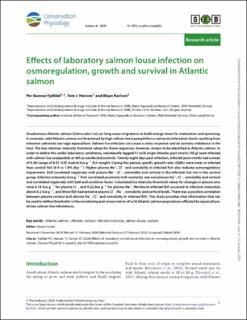| dc.description.abstract | Anadromous Atlantic salmon (Salmo salar) rely on long ocean migrations to build energy stores for maturation and spawning. In seawater, wild Atlantic salmon are threatened by high salmon lice (Lepeophtheirus salmonis) infestation levels resulting from intensive salmonid sea-cage aquaculture. Salmon lice infection can cause a stress response and an osmotic imbalance in the host. The lice infection intensity threshold values for these responses, however, remain to be identified in Atlantic salmon. In order to define this under laboratory conditions, individually tagged F1 wild origin Atlantic post-smolts (40 g) were infected with salmon lice copepodids or left as uninfected controls. Twenty-eight days post infection, infected post-smolts had a mean of 0.38 (range of 0.07–0.9) mobile lice g−1 fish weight. During this period, specific growth rates (SGRs) were lower in infected than control fish (0.4 vs 1.0% day−1). Higher plasma Na+, Cl− and osmolality in infected fish also indicate osmoregulatory impairment. SGR correlated negatively with plasma Na+, Cl−, osmolality and cortisol in the infected, but not in the control group. Infection intensity (lice g−1 fish) correlated positively with mortality rate and plasma Na+, Cl−, osmolality and cortisol and correlated negatively with SGR and condition factor. Calculated lice intensity threshold values for changes in plasma ions were 0.18 lice g−1 for plasma Cl−, and 0.22 lice g−1 for plasma Na+. Moribund infected fish occurred at infection intensities above 0.2 lice g−1, and these fish had extreme plasma Cl−, Na+, osmolality and cortisol levels. There was a positive correlation between plasma cortisol and plasma Na+, Cl− and osmolality in infected fish. This study provides vital information that can be used to define thresholds in the monitoring and conservation of wild Atlantic salmon populations affected by aquaculture-driven salmon lice infestations. | en_US |
